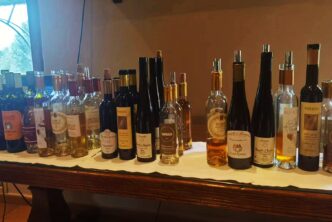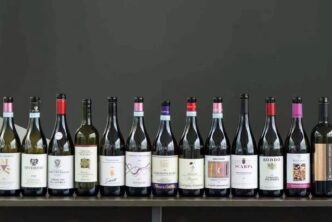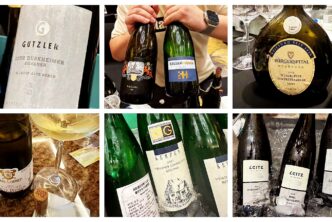Barbaresco has often had to live in the shadow of nearby Barolo, a bigger denomination with many more producers and wines bottled each year (and hence more opportunity for visibility), not to mention with more marketing savvy and moxie. And whereas about as recently as ten to twenty years ago that way of looking at things might have been somewhat justified (many Barbaresco wines were simply not as good as those of Barolo, where producer talent and wine quality level is the highest across the board of any denomination of Italy) that is no longer the case. And it hasn’t been for some time, as Barbaresco’s wines have never been better, which I pointed out clearly in my previous Barbaresco Report (see TerroirSense Wine Review: Barbaresco’s New Releases and More: Stellar 2016s, Difficult 2017s, Surprising 2018s and Highly Promising 2019s, Part I and Ⅱ of March 11 and March 18, 2021).

The truth of the matter is that Barolo and Barbaresco, though they are both 100% Nebbiolo wines and made in two viticultural areas near each other (the closest borders of each denomination are roughly a fifteen-twenty minutes drive apart depending on how you drive) are, quite simply, very different wines. And there are a slew of reasons accounting for why that it is. For example, to continue to refer to Barbaresco as a feminine wine, when it is in fact one of the world’s more powerful wines (ask yourself how a Nebbiolo wine aged years in oak could be anything but), is at best neither accurate nor particularly helpful, and denotes a serious lack of imagination at worst. For sure, Barbaresco wines are blessed by a gentler tannic structure than that of Barolo (and that is in fact how you can tell the two wines apart 90% of the time when tasting blind), but the fact remains that Barbarescos are wines of real clout, structure and ageworthiness. In good vintages, the wines are delicious; in great vintages, they rank with the world’s greatest wines, period. Which brings this discussion to the 2019 vintage.
The 2019 Barbaresco wines
Can you spell the world “outstanding” with three “g’s”? Because the Barbaresco wines of 2019 are so good, so outstanding(gg/ggg) that one final “g” is not enough to write the word with. We’re talking at least two“g’s”-worthiness here, and in the case of the best 2019 Barbaresco wines, easily three “g’s” of goodness.
All kidding aside, the 2019 Barbaresco wines are easily the best since those of 2016, and some of the best in recent memory. In my view the 2019 vintage is, to this point in time at least, one of the top three Barbaresco vintages of the twenty-first century. As a general indication, they are classic wines in the mold of 2016, with slightly less structure but more fruit-forward charm and immediate appeal than that vintage’s great wines. If there is one thing that I especially like about the best 2019 Barbarescos is the silkiness of the tannins, that in the case of the top wines can be even superior to that of the 2016s (and though I remain of the belief that 2016 is still the superior of these two memorable years, both vintages have given unbelievable Barbaresco wines many of which will go down in memory and history). The best 2019 Barbarescos are wines marked by rich glossy fruit, vibrant acidity, supple tannins and impeccable balance. Honestly, there’s hardly more that any wine lover worthy of his “Nebbiolo supporter” pin could ask for. Most importantly, as it always happens in classic years when the hang time is prolonged and there is an absence of extreme weather (such as for example heat spikes and droughty conditions), the sense of site is clearly expressed in your glass of 2019 Barbaresco. In other words, the 2019 Barbarescos convey very well what each vineyard district is all about and what each can deliver (in the hands of competent producers), something that is almost next to impossible in hot years like 2017. And while the instant gratification many of 2019’s Barbarescos provide will make it hard to resist pulling the corks on them right away, these beautiful wines will age well, and then some.

In ultimate analysis, I have no doubt that, unlike it was for many recent overhyped vintages of both Barolo and Barbaresco (for example, just check out what was written when the overall hardly memorable 2011s and 2012s were released, and the silly high scores of many of those wines), 2019 is the real thing. Wise Barbaresco-loving individuals will stock up on these wines, as I hope they did with the 2016s. And while those two vintages mature in your cellar, you can go ahead and enjoy the 2013s (entering their optimal drinking phase now but will last another ten years and beyond easily) and even the underrated 2018s (which are actually good to go now, though they too will benefit from another couple of years of cellaring).
The 2019 Barbaresco growing season weather
The best word by which to describe the 2019 growing season’s weather in Barbaresco is “slow”. Slow in the sense that things started out slowly and proceeded that way for the rest of the year. The 2018 winter season lasted longer than usual (or at least, “usual” by the standards of these climate change times), well into February. Spring arrived late, and it was a cold and rainy one well into mid-March. After a brief spell of good weather, copious rainfall hit again in April, and both rain and lower than usual seasonal temperatures continued into May. All of which meant as much as a two weeks delay in the physiologic development of the grapevines relative to previous years (but more in line with the vintages of the late-1980s and 1990s). The only truly hot spell of the 2019 growing season was recorded at the end of June and first part of July, while storm activity at the end of July was cause for concern (though ultimately little damage was done to the vineyards). What had been a relatively warm summer was followed by a fall of cooler weather (but not the hail that was recorded on September 5 in other parts of the Langhe, such as in the flatland vineyard areas of the Serralunga hill near Gallo d’Alba) which led to a prolonged hang time and important diurnal temperature variation. This meant that the Nebbiolo could be harvested in mid-October, allowing for the potential production of complex, age-worthy wines. Slow really is best, sometimes.
About Ca’ del Baio
I have chosen to shine the spotlight on the quality of the 2019 vintage in Barbaresco with the aid of the wines of the Ca’ del Baio estate, because I find they are the epitome of what great Barbarescos it was possible to achieve in 2019. Simply put, this is the best lineup of Barbarescos I have ever had from Ca’ del Baio: there may have been better individual bottlings made at the estate in other vintages, but I simply do not recall such excellence across their Barbaresco portfolio as I encountered in 2019. These wines are a harbinger of the greatness that awaits in 2019 Barbaresco and that you can read about in my annual Barbaresco New and Recent Releases report that will be out in mid-November.

Ca’ del Baio, actually founded back in 1938, began taking shape as a winery when Giuseppe Grasso, the great-grandfather of the current owners, Giulio and Luciana Grasso, parents of their trio of talented daughters essentially running the estate now (in alphabetic order, Federica, Paola and Valentina Grasso) moved in1870 with his family from Calosso d’Asti to the Treiso area (Treiso is one of the four communes of today’s Barbaresco wine denomination) where he bought the Vallegranda farmhouse (cascina, in Italian). The Grasso sisters have told me time and again that it’s really not clear to them what prompted the move, for the area around Calosso was more fertile and assured better/larger crops than that of Barbaresco, which was in that day and age mired in living conditions of real poverty (so much so that Ernesto Grasso, one of Giuseppe’s descendants, thought long and hard of moving his own family back to where they had come from). As it happens, the Grasso family has quite the ties to wine and Giuseppe’s descendants built quite the respective careers. Silvio picked up his things and moved to La Morra, where he established the famous Silvio Grasso estate of Barolo; Pierpaolo founded Cascina Pier; and Ernesto founded the estate initially known as Grasso Fratelli di Grasso Ernesto. However, all those Grassos led to mountain-like levels of confusion (especially on the part of the local postman who could never get his deliveries straight!). And so it was that the name of the Grasso Ernesto estate was changed to that of Cascina Vallegrande di Ernesto Grasso e di Fratelli Grasso. But that didn’t seem like a great choice either (there is now a Grasso Fratelli estate too) and ultimately the choice fell on the current name, Ca’ del Baio (of which there are at least three others so-named in Italy, but they were the first to register the name as such), roughly translating to the “home of the wild horse” (a horse is the winery’s logo).
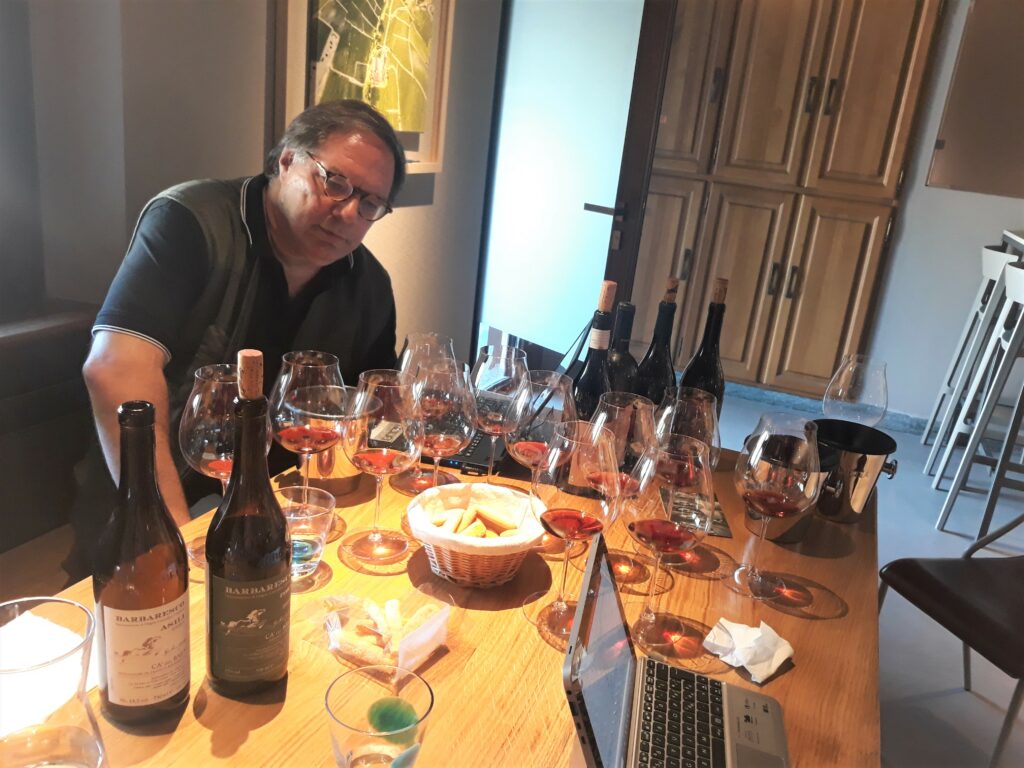
In 1955, Ernesto married Fiorentina, who was from Barbaresco and this led to the Grasso family becoming owners of vineyards not just in Treiso’s territory but in the area of Barbaresco too. The family also began buying vineyards actively in the late 1980s and so today the estate owns roughly 25 hectares between Treiso (with vineyards in the prestigious districts of Vallegrande and Marcarini) and Barbaresco (with vineyards in the prestigious districts of Asili and Pora) and another five hectares in Alta Langa. Consider that the family had begun with what amounted to only 33 giornate of land (a giornata is a unit of measurement that, though it varies from commune to commune in Piedmont, amounts to roughly 3180 meters squared of land, or the equivalent of what extension could be worked by a man and oxen in one day’s time) in Treiso, and that they were originally selling their grapes to the local cooperative. By contrast, today they own a much greater amount of land in some of the denomination’s most famous vineyard sites and make some of its best wines too: so it’s hard to argue with this Grasso family’s success.
The wines in this report
Ca’ del Baio 2019 Barbaresco Autinbej 93
Bright medium red-ruby. Clean, precise aromas of strawberry, raspberry, sandalwood and pungent herbs, with a whiplash of minerals and violet for added complexity. Light and fresh on entry, then more steely and rigid in the middle, with delicate red berry flavours and youthfully dusty tannins. Finishes with a light spice touch on the long nervy back end. A classic Barbaresco that’s good now but better in one to two years, this is much fruitier and enjoyable than the very good but not exceptional 2018 Autimbej.
First made with the 2014 vintage, the Autimbej is Ca’ del Baio’s classic Barbaresco made from the assembly of grapes from three vineyard areas Marcarini, Montersino and Ferrere. Ferrere is characterized by a lighter, sandy-rich soil and gives a lighter-styled wine; Montesino gives an even lighter-styled wine that is very elegant but that does not have much structure; by contrast, Marcarini gives very good structure but also noteworthy perfume. Of those three, Marcarini is an especially good vineyard area, the wines of which fall in my opinion and experience somewhere in between in style of those from Asili and Vallegrande. I have often told the Grasso sisters they should consider bottling it on its own (about the only thing that could hold them back from doing so, and I understand it, is the relatively young age of the vines). The vine age in all three sites averages about fifteen years. Drinking window: 2023-2035.
Ca’ del Baio 2019 Barbaresco Vallegrande 95
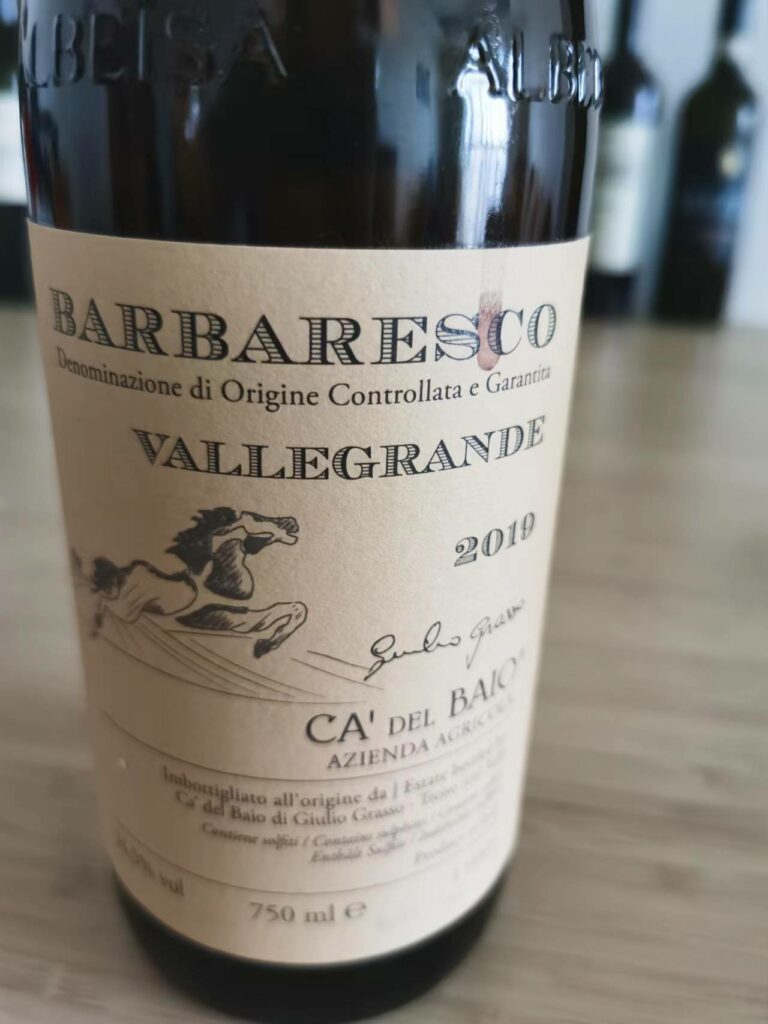
Good full lively red-ruby. Deep, piercing mineral-etched aromas of red rose, violet, sour red cherry, raspberry, and wild herbs, plus a menthol topnote on the inviting nose. Tangy and focused, with brooding red berry and cherry pit flavours, youthful acidity and firm tannins this is a very promising but still very much closed young Barbaresco that is only hinting at what it will become one day. It is, in my modest opinion, the best Barbaresco Vallegrande Ca’ del Baio has ever made. Always more floral than it is fruity, I’d give this about three to four years to unfold and enjoy for another fifteen after that. Ca’ del Baio is the only winery making a Barbaresco Vallegrande today (along with their cousins of the Fratelli Grasso estate). Barbaresco lovers should note that Vallegrande is where Ca’ del Baio owns its oldest Nebbiolo vines (the oldest of which were planted in 1967) and it’s even more noteworthy to know that it’s almost all Nebbiolo Michet (for more information on this specific Nebbiolo biotype, I refer you to my lengthy chapter on Nebbiolo Michet in my recent book Barolo Terroir: Grapes Crus People Places (available from Amazon Press), though I will be discussing it again relative to Barbaresco specifically in my upcoming book on Barbaresco out early next year). Drinking window: 2025-2038.
Ca’ del Baio 2019 Barbaresco Asili 98
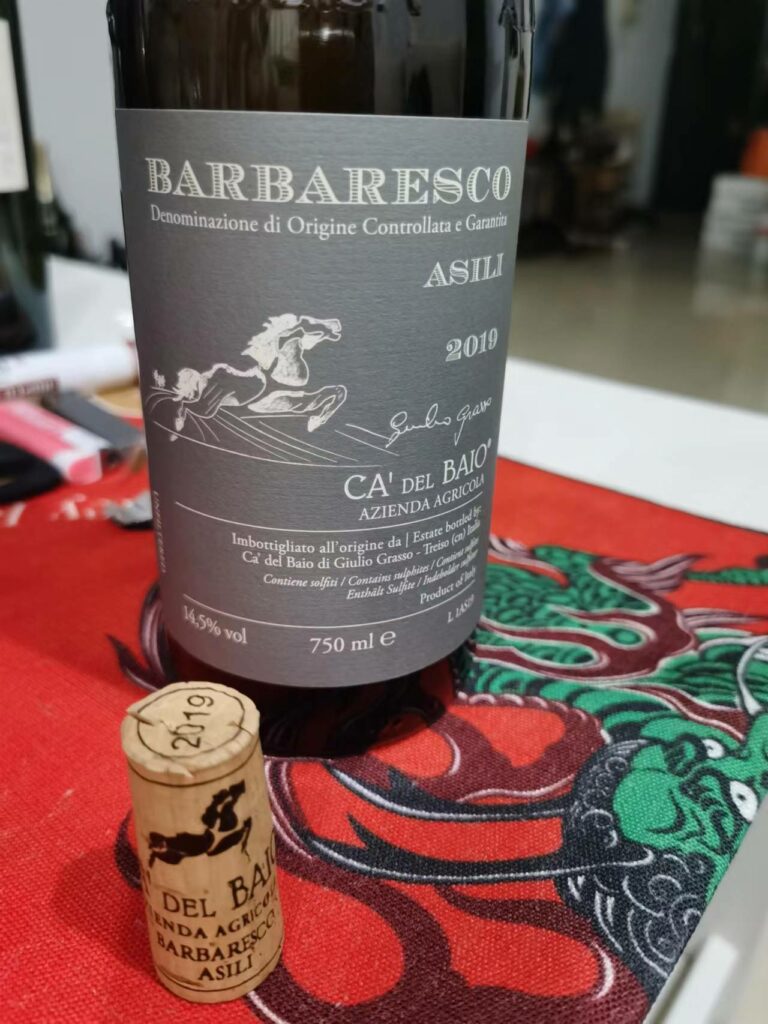
Now this is a gem. Moderately saturated vivid red-ruby colour. Captivating aromas of sour red cherry, cinnamon, red rose, violet, minerals and exotic woods. Silky and sweet on entry, with expressive red fruit flavours and repeating hints of cinnamon and nutmeg, then light and lifted in the middle. Boasts an amazingly suave texture but with obvious concentration of fruit and a truly impressive multi-layered quality on the long pliant finish. Seductive and delicious right now, with impressively pure red berry tones lingering nicely, this is an absolutely fantastic Barbaresco that will age extremely well (the Grasso sisters think it will be best before 2035). The Grasso family can be absolutely proud of what they have come up with here. I have no doubts this will turn out to be one of the top five or six Barbarescos of the vintage. Drinking window: 2025-2040.

 中文
中文

